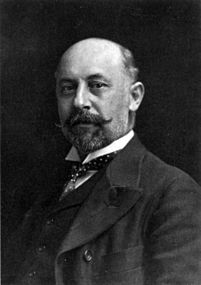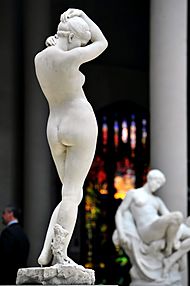Frederick Ruckstull facts for kids
Frederick Wellington Ruckstull (born May 22, 1853 – died May 26, 1942) was an American sculptor and art critic. He was born in France but moved to the United States when he was very young. He became known for his realistic and detailed sculptures.
Life and Career of a Sculptor
Frederick Ruckstull was born in Breitenbach, France. When he was about two years old, his family moved to St. Louis, Missouri in the United States. He tried different jobs, but none of them felt right. Then, when he was in his early twenties, he saw an art show in St. Louis. This show inspired him to become a sculptor.
He started studying art in St. Louis. To save money for more studies, he worked as a toy store clerk for several years. In 1885, he finally saved enough to go to Paris, France, for three years. There, he studied at a famous art school called the Académie Julian. He learned from well-known sculptors like Gustave Boulanger and Antonin Mercié.
When Ruckstull came back to the U.S. in 1892, he opened his own art studio in New York City. His sculpture called Evening won a big award at the 1893 World's Columbian Exposition, which was a huge fair. Because of this award, he was asked to create a large statue of Major-General John F. Hartranft for Pennsylvania State University. In 1893, he also started teaching modeling and marble carving at the Metropolitan Museum of Art Schools in New York.
Ruckstull also created many sculptures that honored historical figures and events from the American Civil War, especially those related to the Southern states.
He helped start the National Sculpture Society. He was also the editor of an art magazine called Art World. In this magazine, he often wrote about his strong opinions on art. He believed in traditional, realistic art and was critical of newer, more modern art styles that were becoming popular.
In 1925, he wrote a book called Great Works of Art and What Makes Them Great. This book was a collection of his essays about art. His own sculptures were made in the Beaux-Arts style, which means they were very realistic and detailed. He and other sculptors of his time, like Daniel Chester French, supported the traditional way of teaching art in studios and showing art in special exhibitions.
Frederick Ruckstull got married in 1896 and had one son. He passed away in New York in 1942, a few days after his 89th birthday.
Notable Sculptures
Here are some of the famous sculptures created by Frederick Ruckstull:
- Soldiers' and Sailors' Monument: This monument is also known as Victory or the Peace Monument. You can find it in Major John Mark Park in Jamaica, Queens, New York City (made in 1896).
- Wade Hampton: This statue is part of the National Statuary Hall Collection at the United States Capitol (made in 1929).
- Wade Hampton: An equestrian (on horseback) statue located on the South Carolina State House grounds (made in 1906).
- Wisdom and Force: These two sculptures are at the Appellate Division Courthouse of New York State.
- Altar to Liberty: Minerva: This sculpture is in Green-Wood Cemetery in Brooklyn, New York (made in 1920).
- Dongan Oak Monument: Located at Battle Pass in Prospect Park, Brooklyn, New York (made in 1922).
- Uriah Milton Rose: Another statue in the National Statuary Hall Collection at the United States Capitol.
- Confederate Monument: Located in Baltimore, Maryland.
- Phoenicia: Found at the Alexander Hamilton U.S. Custom House in New York.
- Defense of the Flag: Located in Little Rock, Arkansas.
- John C. Calhoun: Part of the National Statuary Hall Collection at the United States Capitol.
- Confederate Soldiers and Sailors Monument: Also in Baltimore, Maryland, dedicated in 1903.
Images for kids
-
Evening (1891), a sculpture in the collection of the Metropolitan Museum of Art







